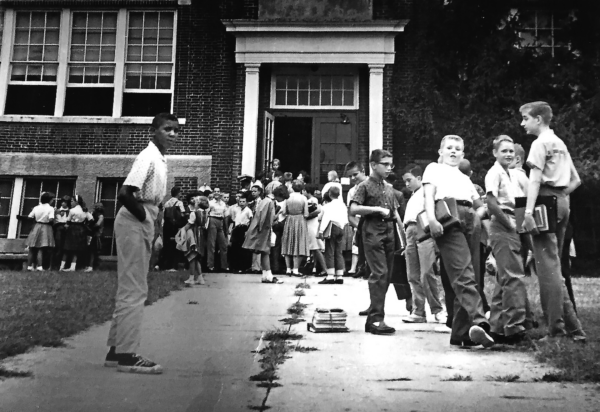The Justice Department's Decision To End School Desegregation: Analysis And Impact

Table of Contents
The Supreme Court's Role and Shifting Legal Interpretations
The legal landscape surrounding school desegregation is complex and constantly evolving. The landmark Brown v. Board of Education (1954) ruling declared state laws establishing separate public schools for black and white students unconstitutional, marking a pivotal moment in the fight for civil rights. However, the implementation of Brown proved a protracted and challenging process. Subsequent Supreme Court cases shaped the interpretation and enforcement of desegregation mandates, significantly influencing the Justice Department's approach.
-
Key Supreme Court cases and their impact: Brown v. Board of Education established the principle of "separate but equal" as inherently unequal. Later cases, such as Milliken v. Bradley (1974), limited the scope of desegregation remedies, impacting the ability of courts to address de facto segregation. Cases like Parents Involved in Community Schools v. Seattle School District No. 1 (2007) further restricted the use of race-conscious measures to achieve integration.
-
Changes in legal interpretation over time: The Court's interpretation of "de jure" (segregation mandated by law) versus "de facto" (segregation resulting from residential patterns) segregation has significantly impacted desegregation efforts. The shift towards a narrower interpretation of what constitutes unconstitutional segregation has limited the government's ability to intervene.
-
Specific examples of how court rulings affected desegregation policies: The Milliken decision, for example, significantly constrained the ability of federal courts to order busing across school district lines to achieve racial balance, contributing to the persistence of segregated schools in many areas.
The Justice Department's Policy Changes and Rationale
The Justice Department's policy shift regarding school desegregation has involved a gradual withdrawal from active enforcement of desegregation orders and a decreased emphasis on proactively addressing racial imbalances in schools. This shift has been characterized by:
-
Specific policy changes made by the DOJ: A reduction in the number of desegregation cases pursued, a shift in focus from court-ordered remedies to voluntary compliance measures, and a lessened emphasis on investigating instances of re-segregation.
-
Official statements and justifications from the DOJ: The DOJ has cited concerns about the effectiveness of court-ordered desegregation remedies, the limitations imposed by Supreme Court decisions, and a desire to promote local control over schools.
-
Criticisms and counter-arguments to the DOJ's reasoning: Critics argue that the DOJ's rationale ignores the persistent reality of racial segregation in many school districts and the ongoing need for federal intervention to ensure equal educational opportunities for all students. They point to the detrimental impact on minority students and the perpetuation of systemic inequalities.
The Impact on Affected Communities and Students
The consequences of the Justice Department's decision are profound and far-reaching. The impact on school demographics and educational opportunities is undeniable:
-
Data on school segregation trends after the policy change: Studies have shown a resurgence of racial segregation in many school districts since the Justice Department’s reduced enforcement. Data reveals growing disparities in school resources and achievement levels between predominantly white and minority schools.
-
Examples of affected communities and their experiences: Numerous communities, particularly those with historically marginalized populations, have experienced the negative effects of increasing school segregation, impacting students' educational attainment, future opportunities, and overall well-being.
-
Long-term effects on educational attainment and achievement gaps: The re-segregation of schools exacerbates existing achievement gaps, limiting opportunities for minority students and perpetuating cycles of inequality. This impacts not only individual students but the broader societal implications of a less equitable education system.
Future Implications and Potential Legal Challenges
The Justice Department's decision is not the end of the story. Several key issues remain:
-
Potential legal avenues for challenging the DOJ’s stance: Civil rights organizations and individuals may continue to challenge the DOJ's approach through litigation, seeking to compel enforcement of existing desegregation orders and to advocate for stronger federal action to address racial disparities in education.
-
Ongoing activism and advocacy related to school desegregation: Grassroots movements and advocacy groups are actively working to raise awareness about the issue, to push for policy changes at local and federal levels, and to promote strategies to achieve greater school integration.
-
Predictions about the future of school desegregation in the US: The future of school desegregation remains uncertain. The extent of future legal challenges, the evolving political landscape, and ongoing societal discussions will shape the trajectory of this critical issue.
Conclusion: The Enduring Legacy of the Justice Department's Decision on School Desegregation
The Justice Department's decision to scale back its efforts on school desegregation has significant implications for educational equity and racial justice in the United States. This analysis has highlighted the complex interplay of legal interpretations, policy shifts, and their consequences for affected communities. The enduring legacy of this decision will be shaped by future legal challenges, ongoing activism, and the commitment of individuals and organizations to the fight for school desegregation. The struggle for equal educational opportunities for all students remains a vital aspect of American society, demanding continued engagement and advocacy. To learn more about the ongoing struggle for school desegregation and to find ways to get involved in promoting equal educational opportunities for all students, consider exploring resources from organizations like the NAACP Legal Defense and Educational Fund and the ACLU. Let's continue the conversation and work towards effective school desegregation efforts.

Featured Posts
-
 Serie Joseph Tf 1 Critique Et Analyse De La Nouvelle Serie Policiere
May 03, 2025
Serie Joseph Tf 1 Critique Et Analyse De La Nouvelle Serie Policiere
May 03, 2025 -
 Rome L Ombre De Macron Sur Le Prochain Conclave
May 03, 2025
Rome L Ombre De Macron Sur Le Prochain Conclave
May 03, 2025 -
 2027 Metai Sanchajus Ruosiasi Priimti Hario Poterio Parka
May 03, 2025
2027 Metai Sanchajus Ruosiasi Priimti Hario Poterio Parka
May 03, 2025 -
 The Future Of Mobile Gaming Valorant Mobiles Potential
May 03, 2025
The Future Of Mobile Gaming Valorant Mobiles Potential
May 03, 2025 -
 I Diafthora Stis Poleodomies Mia Apeili Gia Tin Epanidrysi Toy Kratoys Dikaioy
May 03, 2025
I Diafthora Stis Poleodomies Mia Apeili Gia Tin Epanidrysi Toy Kratoys Dikaioy
May 03, 2025
Latest Posts
-
 Pm Modis France Visit Ai And Business At The Forefront
May 03, 2025
Pm Modis France Visit Ai And Business At The Forefront
May 03, 2025 -
 Indias Pm Modis France Trip Key Events Including Ai Summit And Ceo Forum
May 03, 2025
Indias Pm Modis France Trip Key Events Including Ai Summit And Ceo Forum
May 03, 2025 -
 Reaction De Macron Face A La Souffrance Visite Emouvante Aupres De Victimes Israeliennes
May 03, 2025
Reaction De Macron Face A La Souffrance Visite Emouvante Aupres De Victimes Israeliennes
May 03, 2025 -
 La Rencontre Poignante De Macron Avec Les Victimes Israeliennes Une Image Forte
May 03, 2025
La Rencontre Poignante De Macron Avec Les Victimes Israeliennes Une Image Forte
May 03, 2025 -
 L Emotion De Macron Apres Son Entretien Avec Les Victimes De L Armee Israelienne
May 03, 2025
L Emotion De Macron Apres Son Entretien Avec Les Victimes De L Armee Israelienne
May 03, 2025
